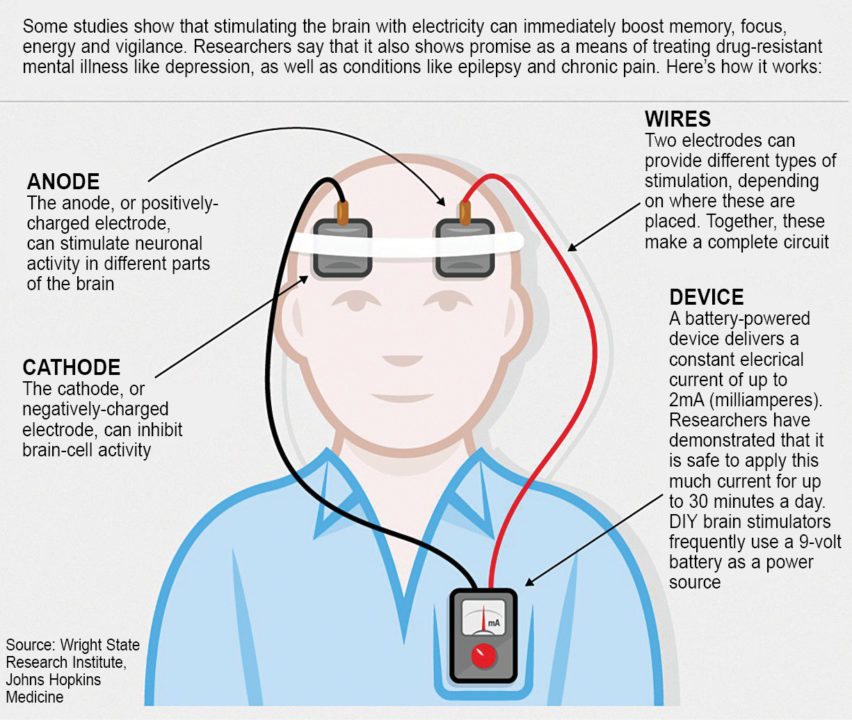Electric dominance of the brain working is well confirmed and established by health and neural sciences. Electric signals within the brain not only govern/control the working of the human body, but according to recent medical studies, these signals with suitable electric brain stimulation techniques can be controlled to enhance the desired activities of the human body like motion, memory, health, peace and more. This article aims to bring to the reader such useful outcomes of electric brain stimulation, but with caution that such technology should be used under proper medical expert supervision.

Electric brain stimulation in its current form may be relatively new, but humans have been tinkering with the brain for centuries. Electrical brain stimulation, also referred to as focal brain stimulation (FBS), is a form of electrotherapy. This technique is used in research and clinical neurobiology to stimulate a neuron or neural network in the brain through direct or indirect excitation of its cell membrane by using an electric current.
Electrical brain stimulation was first used in the first half of the 19th century by pioneering researchers such as Luigi Rolando (1773 – 1831) and Pierre Flourens (1794 – 1867), to study the brain localisation of function, following the discovery by Italian physician Luigi Galvani (1737 – 1798) that nerves and muscles were electrically excitable.
In the following century, the technique was improved upon by the invention of the stereotactic method by British neurosurgeon pioneer Victor Horsley (1857 – 1916) and by the development of chronic electrode implants by Swiss neurophysiologist Walter Rudolf Hess (1881 – 1973), José Delgado (1915 – 2011) and others, by using electrodes manufactured by straight insulated wires that could be inserted deep into the brain.
Two-photon excitation microscopy has shown that micro-stimulation activates neurons sparsely around the electrode even at low currents (as low as 10µA), up to distances as far as 4mm away. This happens without particularly selecting other neurons much nearer the electrode’s tip. This is due to activation of neurons being determined by whether these have axons or dendrites that pass within a radius of 15µm near the tip of the electrode. As current is increased, volume around the tip that activates neuron axons and dendrites increases and, with this, the number of neurons that are activated. Activation is most likely to be due to direct depolarisation rather than synaptic activation.
Techniques of electric brain stimulation
Medical experts and companies have developed a variety of non-invasive brain stimulation technologies such as cranial electrotherapy stimulation (CES), deep brain stimulation (DBS), transcranial direct current stimulation (tDCS), electroconvulsive therapy (ECT), functional electrical stimulation (FES), magnetic seizure therapy (MST), vagus nerve stimulation (VNS) and deep transcranial magnetic stimulation (deep TMS).
tDCS is getting loads of attention from early adopters who rave about its potential, and scientists who are trying to unravel what it can and cannot do. It is a non-invasive form of brain stimulation that involves passing a current between electrodes on the scalp. The technique is one of a number of technologies being tested to see if it can enhance cognitive functions such as boosting the performance of drone pilots or image analysts.
According to the experts, the current is set to about 2mA, which is about 1000 times less than the electrical current that flows through a typical iPad charger, and only about 1/50th of that current makes it through the skull to the brain. The stimulation is said to last for about ten minutes, and is aimed at the right inferior frontal cortex and the right anterior temporal lobe, which are brain areas thought to be important for learning.
A mild stinging sensation is felt where the electrode is attached to the head. This is thought to be a normal feeling, but if the sensation continues, it is better to turn off the connection and try to get a better connection.
Next, people notice a slight taste of metal in their mouth, a common side effect of tDCS, according to experts.










